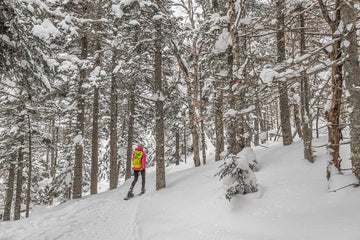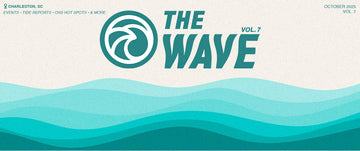Unlike ski jumping or ice climbing, which takes years of training and falling before you start to have fun, snowshoeing can be fun from the get-go. In fact, it’s simple enough for some to have referred to it as a two-step process:
- Take a step with your left foot.
- Take a step with your right foot.
You’re in!
True, you may still end up falling. But we bet you’ll be having loads of laughs on the way down. If you do it right, of course. That means:
- Get the right gear
- Wear the right clothes
- Know the right stuff
What to Get

No matter how creative you may be making nightstands out of milk crates and tabletops out of old barn doors, you don’t want to make your own snowshoes. Sure, it might seem like you could simply tie a couple of tennis rackets on your feet and head for the hills. But in truth, you wouldn’t be heading anywhere.
Invest in a quality pair of snowshoes that are right for:
- Your weight
- The terrain
- The snow conditions
Your weight: Snowshoes come with a “recommended load.” This is the maximum weight they are designed to take without buckling, breaking or sending you into the depths of a snowbank.
Take your body weight into account, along with the extra pounds for extra clothing and gear. You are packing some gear, right?
The terrain: Skip the mountains—or even the hills—if you’re new to snowshoeing (which you are if you’re reading this guide). Adventure out on flat terrain, and a pair of flat-terrain snowshoes. They’re designed for easy trekking on flat to slightly rolling terrain. They’re also the lightest and least expensive type of snowshoes in the bunch.
The snow conditions: Smaller snowshoes are better for wet, compact snow. Larger snowshoes are the best pick for powdery snow. Not sure what type of snow is out there? Head out and shovel a load. If it hurts your back, it’s the heavier, wet, compact snow.
The Right Poles
Some say poles are optional. We say they’re about as optional as breathing. Just get them. They’ll give you better traction and stability, making your adventure easier, safer and more fun. Opt for adjustable poles with snow baskets. Easy-peasy and right for your height.
The Right Gear
Take along the same type of gear you’d take on any hiking adventure. Water. Snacks. A picture of your cat. Some duct tape wrapped around one of your poles for quick snowshoe repairs. Your phone. Your lip balm. A map.
What to Wear

If you do it right, dressing for a winter adventure may take nearly as long as the actual adventure itself. That’s because layers are where it’s at, with your weatherproof parka piled over a UPF 50 long-sleeve shirt, piled over a carefully crafted collection of base layers.
Dressing in layers is one part art, one part science, and three parts sun protection neck gaiter. Yes. Three. Use one UV gaiter around your neck and the other two around the top of your boots to stop the snow from seeping in. Clever, right?
Here come more details on the layering process from the bottom up:
Feet: You already know you need the snowshoes. Pick a warm, waterproof pair of boots to go with them. Winter hiking boots are on the mark. Designer cowboy boots aren’t. Opt for cozy socks and a UV gaiter or two. Use the gaiters at the top of your boots to stop the snow from seeping in.
Base layers: Women's leggings are a great pick, as are other close-to-the-skin pants you can wear beneath snow pants if desired. Go for active wear designed for aerobic activity, like men's and women's sun protection shirts (or kids' sun protection shirts if the outing is a family affair).
Middle layers: Choose mid layers that have a bit more heft than your base layers. A hooded sun shirt works well here, as does a long-sleeve performance shirt or lightweight UV hoodie. If temps are expected to really dip, a Sherpa pullover can do the trick.
Top layers: The outer layer is where all the weatherproofing comes in. Weatherproof shell jacket. Weatherproof snow pants. Don’t forget your gloves, hat, scarf and sunglasses.
For all layers, choose synthetic performance fabrics or wool over cotton. They’re better at wicking away moisture to keep you warm and dry.
What to Know

Knowing the weather forecast is a given. That way you can adjust your layers to best suit the outside temperatures. And you’ll know if you’d rather stay in and watch Netflix.
Other things you need to know:
Stretch and prep: Stretching your legs and hips before you go is a good idea, since snowshoeing requires longer steps and a wider stance than you’re normally used to.
Beware of morning snow: That fresh morning, glorious glisten on the snow may be ice, thanks to colder morning temps. Take a few test steps before you barrel forward on an early morning adventure.
Fresh snow requires breaking-in: Snowshoeing over fresh snow is a heck of a lot tougher than snowshoeing over a firmly trodden path. Take turns leading the pack, so everyone gets the pleasure of breaking-in fresh snow.
Don’t be rude: Snowshoeing etiquette says not to trample all over the groomed tracks used by cross-country skiers. Stay off tracks made by snowmobiles, too. You never know when another one may be coming. Good etiquette says to stay on the edges of the trails and tracks, giving skiers and snowmobiles the right of way.
Try the zigzag: If you’re faced with steeper terrain, try zigzagging toward the top instead of taking on the hill head-on. You’re welcome.
Now that you’re aware of what to get, what to wear and what to know, you just need to figure out where to go. Cross-country ski resorts are one option, as are national forests, state parks and anywhere you like to hike in the summer. So gear up, dress warmly, and have fun.





